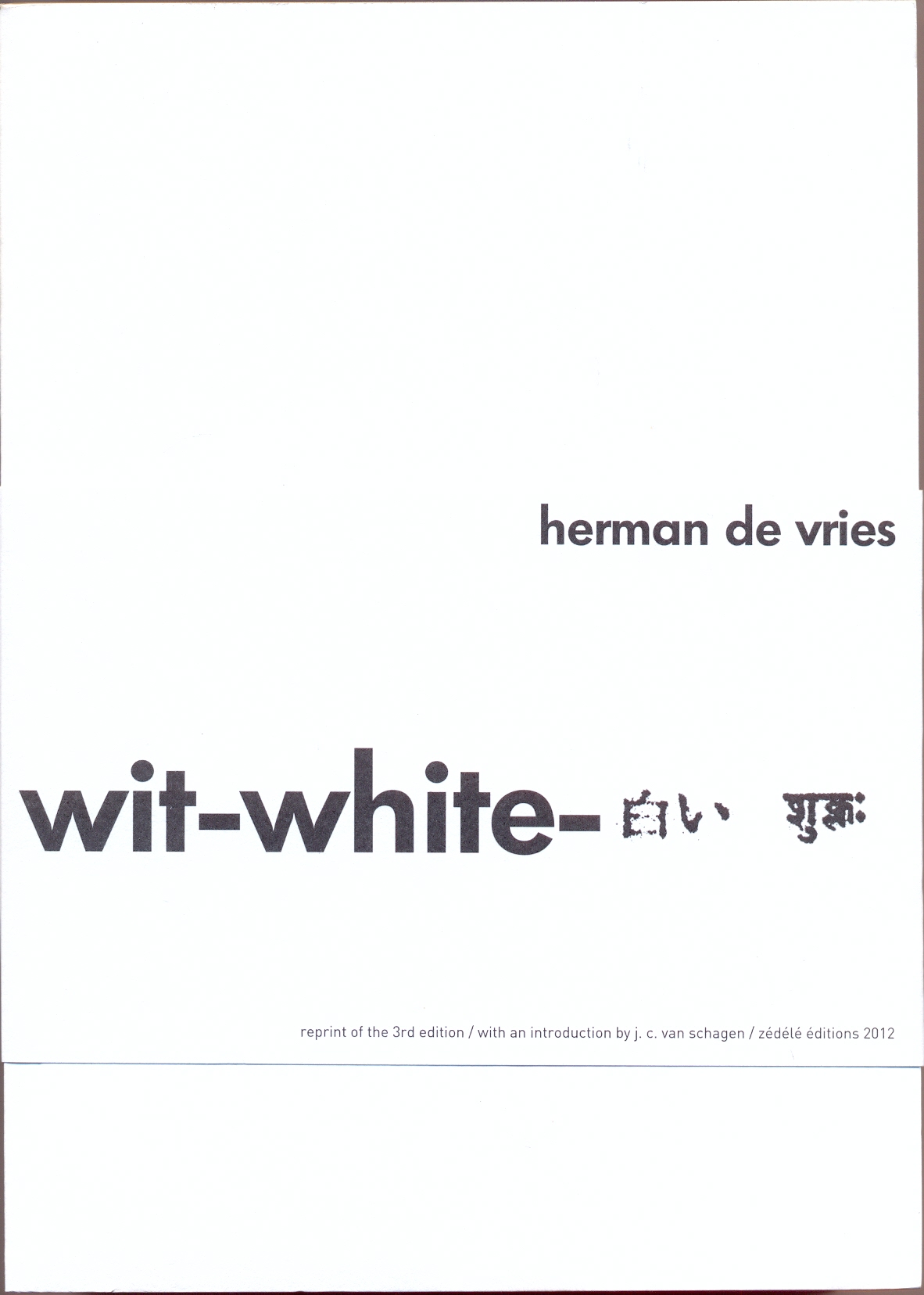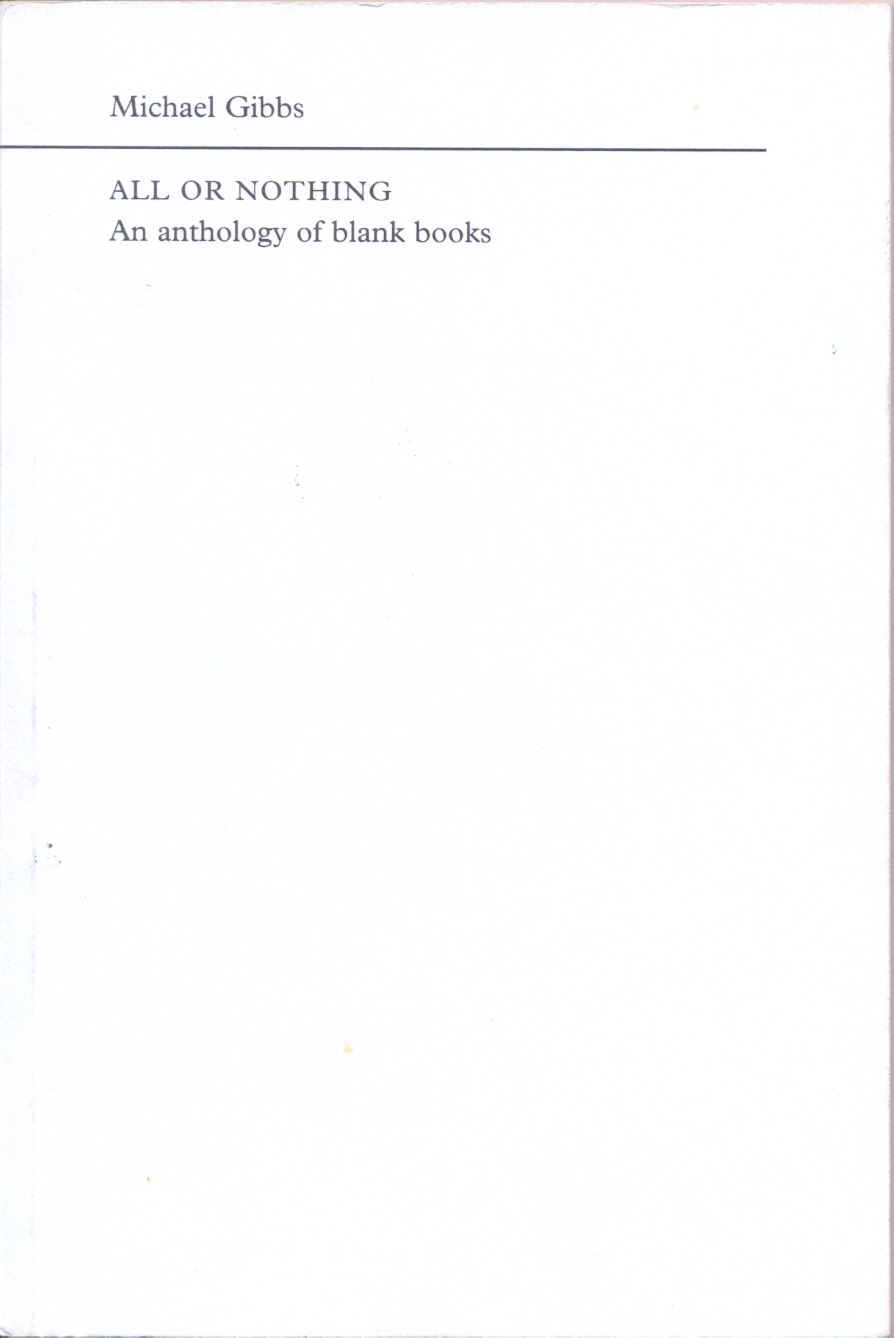
herman de vries
wit = white
Brest: Éditions Zédélé, 2012 [Artists Press, Berne, 1980]
15 x 21 cm
[352 p.]
Brochura
ISBN 9782915859416
Edition originale / First edition:
Artists Press, Bern, 1980
Este livro é a terceira e mais recente versão do primeiro livro do artista, publicado em 1960. Herman de Vries tem mais de uma centena de livros publicados. É na indústria do livro um equivalente óbvio para as pinturas brancas de Rauschenberg (1951) e a composição 4’33” de John Cage (1952).
A história deste livro remonta a 1960. Membro do grupo Zero, mas também atraído pelo conceito budista de vazio, herman de vries havia realizado pinturas monocromáticas brancas quando publicou em Arnhem um livreto de vinte páginas. Ele não tinha título, sua capa era branca e as páginas não eram impressas. Apenas um curto poema famoso no final, em quatro línguas, “o branco é superabundante”. Este livro-manifesto ganhou outra versão em 1962 sob a brancura do título: duzentas páginas em branco, quatro colagens brancas do artista e uma introdução, totalmente vazia, do poeta JC van Schagen. Editado cinco cópias apenas por MJ Israel em Arnhem, será seguido em 1967 por uma segunda edição, “revista”, wit weiss: duzentos e cinquenta páginas em branco em formato de bolso, quinhentos exemplares, publicado por Hansjörg Mayer em Stuttgart. Como elementos impressos havia apenas: autor, título e editor na capa, a menção da introdução e seu autor na primeira página, o colofão na última página.
Em 1980 foi publicado pelo Artists Press em Berna, em um formato maior, com mais páginas, a “terceira edição revisada.” O título original “wit” foi traduzido para o Inglês, Japonês, bem como uma palavra sânscrita que significa “branco” no sentido de brilhante, puro, imaculado. Mas este título não aparece no livro, perfeitamente branco. Foi impresso como um paratexto sobre uma ampla cinta de papel, no lugar da sobrecapa removível. Na aba interna, pode-se ler uma breve declaração cuja redação remonta à edição de 1962, que afirma que este é um livro total e contém todos os aspectos da realidade. Dos cinco mil exemplares anunciados, apenas uma centena foram publicados. É esta última edição, a mais radical, que é reeditada aqui, com o único acréscimo da tradução francesa da declaração. herman de vries, em 1º de abril de 2012, comentou sobre o seu livro, enfatizando a importância da vírgula final:
branco é branco
0 = 0
sem nome
sem ideia
nem mesmo o vazio,
Ce livre est la troisième et dernière version du premier livre d’artiste publié en 1960 par herman de vries, qui en a aujourd’hui plus d’une centaine à son actif. Il est, dans le domaine du livre, un manifeste équivalent aux White Paintings de Rauschenberg (1951) et à 4’33’’ de John Cage (1952).
L’histoire de ce livre remonte à 1960. Alors proche du groupe Zero, mais également attiré par la conception bouddhiste du vide, herman de vries venait de réaliser des monochromes blancs quand il édite lui-même à arnhem un fascicule de vingt pages. Il n’a pas de titre, sa couverture est vierge et les pages ne sont pas imprimées. Seul un bref poème final célèbre, en quatre langues, la surabondance du blanc : « wit is overdaad ». Ce livre-manifeste va connaître une autre version, en 1962, sous le titre wit : deux cents pages blanches, quatre collages blancs de l’artiste et une introduction, totalement vide, du poète J. C. van Schagen. Éditée à cinq exemplaires seulement à arnhem par M. J. Israel, cette publication sera suivie en 1967 d’une seconde édition, « revue », wit weiss : deux cent cinquante pages blanches, au format de poche, en cinq cents exemplaires, publiée chez Hansjörg Mayer, à Stuttgart. Seuls éléments imprimés : auteur, titre et éditeur sur la couverture, mention de l’introduction et de son auteur sur la toute première page, colophon sur la dernière page.
En 1980 paraît chez Artists Press, à Berne, sous un format plus grand, avec davantage de pages, la « troisième édition revue ». Le titre originel wit est traduit en anglais, en japonais ainsi qu’en sanskrit d’un mot qui signifie « blanc », au sens de brillant, pur, immaculé. Mais ce titre ne figure pas sur le livre, parfaitement blanc. Il est imprimé, avec le paratexte, sur une large bande de papier qui tient lieu de bandeau détachable. Sur le rabat intérieur, on peut lire une courte déclaration dont la première rédaction remonte à l’édition de 1962 et qui affirme que ce livre total contient tous les aspects de la réalité. Sur les cinq mille exemplaires annoncés, seule une centaine sera publiée. C’est cette dernière édition, la plus radicale, qui est reprise ici, avec pour seul ajout la traduction en français de la déclaration. herman de vries, le 1er avril 2012, commente ainsi son livre, en insistant sur l’importance de la virgule finale :
blanc est blanc
0 = 0
pas de nom
pas d’idée
pas même le vide,
This book is the third and final version of the first artist’s book published in 1960 by herman de vries, who is currently the author of more than one hundred publications. This is like the White Paintings by Rauschenberg (1951) and 4’33” by John Cage (1952) in book form.
The story of this book dates back to 1960. Closely associated with the Zero Group, but also drawn to the buddhist concept of emptiness, herman de vries had just produced a series of white monochromes when he self-published a twenty-page booklet in Arnhem. It had no title, its cover was blank and its pages were unprinted. It contained nothing but a short final poem celebrating, in four languages, the superabundance of white: “wit is overdaad”. In 1962, this manifesto appeared in another version, now entitled wit: two hundred blank pages, four white collages by the artist and an introduction, itself completely blank, by the poet J. C. van Schagen, published in arnhem in only five copies by M. J. Israel. It was followed in 1967 by a second “revised” edition, wit weiss: two hundred and fifty blank pages, pocket-sized, in five hundred copies, published by Hansjörg Mayer in Stuttgart. The only printed elements were the artist’s name, the title and the publisher’s name on the cover, the word “introduction” and the name of its author on the very first page and a colophon on the final page. In 1980 the Artists Press in Berne published the “third revised edition”, in a larger format and with more pages. The original title wit was translated into english and japanese and into sanskrit with a word that means “white” in the sense of bright, pure, immaculate. The title itself does not appear on the book, which remains completely blank. It is printed with the paratext on a broad strip of paper in the form of a detachable publicity strip. The inside flap contains a brief statement initially dating back to the 1962 edition, stating that this book incorporates all aspects of reality. Of the five thousand copies advertised, only a hundred were published. It is this last edition, the most radical, which is republished here, the only addition being the french translation of the statement.
On 1 april 2012, herman de vries wrote of his book, insisting on the importance of the final comma:
white is white
0 = 0
no name
no idea
not even emptiness,
Salvar


